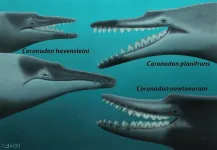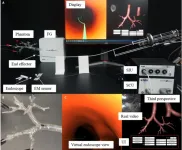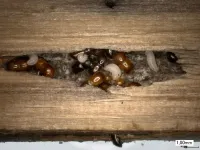(Press-News.org) A new study published in the journal PeerJ by Robert W. Boessenecker (CofC), Brian L. Beatty (NYIT), and Jonathan H. Geisler (NYIT) reports a wealth of new fossils of the early toothed baleen whale Coronodon from Oligocene (23-30 million years old) rock layers near Charleston, South Carolina. These include five new skulls, representing two new species: Coronodon planifrons and Coronodon newtonorum, and young juveniles of Coronodon havensteini – first named from a single skull by this team in 2017. Coronodon is one of the most primitive members of the group that includes living baleen whales – its name translate to “crown tooth” referring to the large, multi-cusped teeth that overlap in the mouth. An ongoing scientfic controversy concerns whether these teeth were used for cutting, filter-feeding, or a combination of both.
The two new species, Coronodon planifrons and Coronodon newtonorum, are found in the same rock layer and date to the same time period (late Oligocene; 25-23 myo). Coronodon havensteini (30-28 myo) is older and is a possible ancestor of these two species. Coronodon planifrons is named after a skull with a flat ‘forehead’ and possibly an extra tooth relative to the other species. Coronodon newtonorum is also known from a single skull and mandible, with slightly smaller teeth and an unusual shaped mouth that made it look like it was permanently ‘smiling’.
New specimens of Coronodon havensteini include an old adult and two calves, and providing a rare window into the early growth and development of an Oligocene whales. Unlike modern dolphins and baleen whales, the snout stays the same length during growth – rather than being shorter in juveniles. The early growth of the snout is probably related to its large teeth, and underscores how important the teeth are to understanding this early whale.
These new specimens and species indicate that Coronodon had a proportionally large head relative to its skeleton, swam in a style much like modern baleen whales, and likely had a flexible chin and joints in the skull that are typically associated with filter feeding. However, Coronodon appears to have lacked baleen. Reconstruction of the evolutionary tree of baleen whales places Coronodon as its earliest branch and this key to understanding the transition from feeding with teeth to feeding with baleen.
END
New specimens and species of the Oligocene toothed baleen whale Coronodon from South Carolina and the origin of Neoceti
The five new skulls represent two new species: Coronodon planifrons and Coronodon newtonorum, and young juveniles of Coronodon havensteini
2023-04-14
ELSE PRESS RELEASES FROM THIS DATE:
New family of wheel-like metallic clusters exhibit unique properties
2023-04-14
While the wheel does not need to be reinvented, there are benefits to the development of new nano-wheels, according to a multi-institute research team based in China. The group fabricated a novel family of metallic compounds, each of which exhibit unique properties desirable for next-generation technologies, such as advanced sensors.
Their findings were made available online on March 12 in Polyoxometalates.
“Polymetallic complexes are of great interest not only for their appealing molecular structure but also ...
How drugs get into the blood
2023-04-14
There is a need for new drugs. For example, many of the antibiotics that we have been using for a long time are becoming less effective. Chemists and pharmaceutical scientists are frantically searching for new active substances, especially those that can penetrate cell membranes, as these are the only ones that patients can take orally in the form of a tablet or syrup. Only these active ingredients pass through the intestinal wall in the small intestine and enter the bloodstream to reach the affected area in the body. For active ingredients that cannot penetrate the cell membrane, physicians have no choice but to inject them directly into ...
A novel robotic bronchoscope system for navigation and biopsy of pulmonary lesions
2023-04-14
Cancers are notoriously known for their high mortality rate and increasing incidence worldwide. Among them, lung cancer is arguably one of the most devastating ones. According to the World Cancer Research Fund International, lung cancer was the second most common cancer around the world in 2020, with more than 2.2 million new cases and 1.8 million deaths.
However, lung cancer, like other cancers, is easier to treat if caught earlier. “The reported 1-year survival rate for stage V is just 15% to 19% compared with 81% to 85% for stage I, which means that the early ...
Black cancer patients 71% more likely to experience heart damage following chemotherapy treatment
2023-04-14
Chemotherapy is associated with an increased risk of treatment-related heart damage, including heart failure and cerebrovascular disease, for many patients. But a new meta-analysis, presented at the American College of Cardiology’s Advancing the Cardiovascular Care of the Oncology Patient 2023 conference, finds that Black patients or patients of African ancestry have 71% higher odds of cardiotoxicity following cancer treatment compared to White patients.
Cardiotoxicity is any heart damage stemming from cancer treatment or drugs, including ...
Optica Publishing Group announces launch of Optica Quantum
2023-04-14
WASHINGTON—On World Quantum Day, Optica Publishing Group announced it will begin publishing a new journal in September 2023 dedicated to highly selective results in quantum information science and technology (QIST). The new journal, Optica Quantum, joins the Society’s portfolio of the most-cited journals in optics and photonics and will provide the community with articles of the same exceptional standards for quality, novelty, and significance as its parent journal, Optica.
The concept of quantum light serves as a foundation for many quantum technologies and ongoing ...
Farmer’ beetle finds suitable host trees by tracing scent of its fungus crop
2023-04-14
The alnus ambrosia beetle Xylosandrus germanus, also known as the black stem borer, was accidentally introduced by humans from its native east Asia to North America and Europe around the beginning of the 20th century. X. germanus is a so-called ambrosia beetle, which means that it farms its own food: a specialized fungal symbiont which it ‘sows’ and tends inside the galleries that it digs inside wood. It is a destructive invasive pest, known to attack more than 200 species from 51 families of broadleaf and conifer trees. While it prefers to colonize dead ...
Treasure hunt in hot springs?
2023-04-14
The demand for precious metals and rare earths is expected to continue increasing in the future. Due to limited production areas, recycling from precision equipment and recovering from seawater and hot spring water are needed to ensure a stable supply.
A research group led by Professor Masayuki Azuma and Associate Professor Yoshihiro Ojima of the Osaka Metropolitan University Graduate School of Engineering has successfully developed an adsorbent material that can selectively recover rare earth elements (REEs) using environmentally friendly and inexpensive baker’s yeast and trimetaphosphate, which is used as a food additive.
The research group conducted experiments using ...
Why did the mpox (monkeypox) epidemic wane? Belgian researchers propose theory
2023-04-14
**Note: the release below is from the European Congress of Clinical Microbiology & Infectious Diseases (ECCMID 2023, Copenhagen, 15-18 April). Please credit the conference if you use this story**
Did the recent mpox (formerly known as monkeypox) outbreak end because of “network immunity”? That’s the theory being put forward by Belgian researchers at this year’s European Congress of Clinical Microbiology & Infectious Diseases (ECCMID) in Copenhagen, Denmark (15-18 April).
2022 saw a global outbreak of mpox, a viral ...
The Lancet Public Health: Hearing aids may protect against a higher risk of dementia associated with hearing loss, study suggests
2023-04-14
Peer-reviewed / Observational study / People
The Lancet Public Health: Hearing aids may protect against a higher risk of dementia associated with hearing loss, study suggests
Study of 437,704 people suggests those experiencing hearing loss and not using hearing aids may have a higher risk of dementia than people without hearing loss. Those using hearing aids did not appear to be at an increased risk of dementia.
After adjusting for other factors, study analysis suggests a 1.7% risk of dementia in people with hearing loss who are not using hearing aids, compared to 1.2% among those without hearing loss ...
One of first studies to assess new bivalent Covid-19 booster vaccine shows it is highly effective in reducing deaths and hospitalizations
2023-04-14
*Note: this is a joint press release from the European Congress of Clinical Microbiology & Infectious Diseases (ECCMID) and The Lancet Infectious Diseases. Please credit both the congress and the journal in your stories*
Since September, 2022, bivalent mRNA vaccines – which contain elements from both the original wild type COVID strain and an updated component from the omicron strain – have replaced older style monovalent boosters in the USA, Israel, and other countries. These vaccines were designed to help improve vaccine-induced immunity against the omicron variant and subsequent subvariants.
A new study published in The Lancet Infectious Diseases and ...
LAST 30 PRESS RELEASES:
On-demand upgraded recycling of polyethylene and construction of sustainable multifunctional materials based on the "LEGO" strategy
New "Stomata in-sight" system allows scientists to watch plants breathe in real-time
Anorexia nervosa may result in long-term skeletal muscle impairment
Narrative-based performance reviews deemed fairest by employees
New insights reveal how advanced oxidation can tackle emerging water pollutants
New review shows how biomass can deliver low-carbon gaseous fuels at scale
Climate change is quietly rewriting the world’s nitrogen cycle, with high stakes for food and the environment
Study finds SGLT-2 inhibitors linked to lower risk of diabetic foot nerve damage
Microbes may hold the key to brain evolution
Study examines how the last two respiratory pandemics rapidly spread through cities
Gender stereotypes reflect the division of labor between women and men across nations
Orthopedics can play critical role in identifying intimate partner violence
Worms as particle sweepers
Second spider-parasitic mite described in Brazil
January 2026 issues of APA journals feature new research on autism, pediatric anxiety, psychedelic therapy, suicide prevention and more
Private equity acquired more than 500 autism centers over the past decade, new study shows
New cervical cancer screening guidelines from the US Department of Health and Human Services
Estimated burden of COVID-19 illnesses, medical visits, hospitalizations, and deaths in the US from October 2022 to September 2024
Smartphone use during school hours by US youth
Food insecurity and adverse social conditions tied to increased risk of long COVID in children
Earliest, hottest galaxy cluster gas on record could change our cosmological models
Greenland’s Prudhoe Dome ice cap was completely gone only 7,000 years ago, first GreenDrill study finds
Scientific validity of blue zones longevity research confirmed
Injectable breast ‘implant’ offers alternative to traditional surgeries
Neuroscientists devise formulas to measure multilingualism
New prostate cancer trial seeks to reduce toxicity without sacrificing efficacy
Geometry shapes life
A CRISPR screen reveals many previously unrecognized genes required for brain development and a new neurodevelopmental disorder
Hot flush treatment has anti-breast cancer activity, study finds
Securing AI systems against growing cybersecurity threats
[Press-News.org] New specimens and species of the Oligocene toothed baleen whale Coronodon from South Carolina and the origin of NeocetiThe five new skulls represent two new species: Coronodon planifrons and Coronodon newtonorum, and young juveniles of Coronodon havensteini





